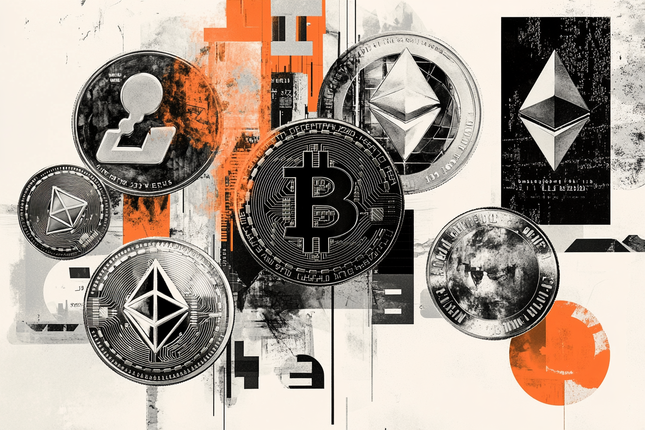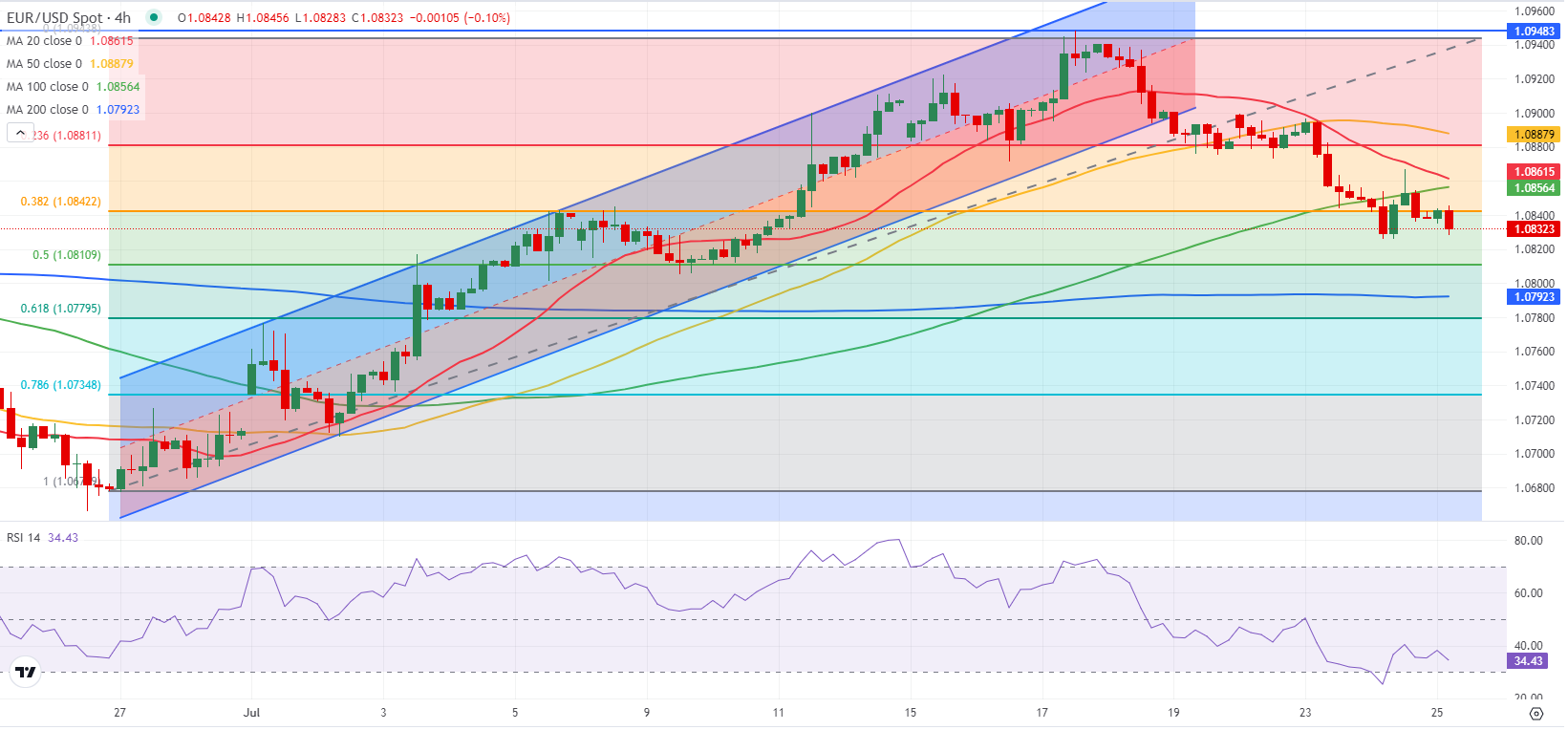- EUR/USD stays on the back foot, trades below 1.0850 early Thursday.
- Safe-haven flows dominate the action in financial markets in the European session.
- The US Bureau of Economic Analysis will release its first estimate of Q2 GDP growth.
EUR/USD struggles to gain traction and trades below 1.0850 in the early European session on Thursday after closing the second consecutive day in negative territory on Wednesday. The near-term technical outlook shows that the bearish bias remains intact.
Euro PRICE This week
The table below shows the percentage change of Euro (EUR) against listed major currencies this week. Euro was the weakest against the Japanese Yen.
| USD | EUR | GBP | JPY | CAD | AUD | NZD | CHF | |
|---|---|---|---|---|---|---|---|---|
| USD | 0.41% | 0.22% | -3.20% | 0.82% | 2.38% | 1.79% | -0.83% | |
| EUR | -0.41% | -0.20% | -3.63% | 0.36% | 2.00% | 1.31% | -1.30% | |
| GBP | -0.22% | 0.20% | -3.53% | 0.55% | 2.20% | 1.50% | -1.12% | |
| JPY | 3.20% | 3.63% | 3.53% | 4.17% | 5.83% | 5.10% | 2.37% | |
| CAD | -0.82% | -0.36% | -0.55% | -4.17% | 1.65% | 0.96% | -1.65% | |
| AUD | -2.38% | -2.00% | -2.20% | -5.83% | -1.65% | -0.68% | -3.25% | |
| NZD | -1.79% | -1.31% | -1.50% | -5.10% | -0.96% | 0.68% | -2.55% | |
| CHF | 0.83% | 1.30% | 1.12% | -2.37% | 1.65% | 3.25% | 2.55% |
The heat map shows percentage changes of major currencies against each other. The base currency is picked from the left column, while the quote currency is picked from the top row. For example, if you pick the Euro from the left column and move along the horizontal line to the US Dollar, the percentage change displayed in the box will represent EUR (base)/USD (quote).
The People’s Bank of China (PBOC), China's central bank, unexpectedly announced on Thursday that it cut the one-year Medium-term Lending Facility (MLF) rate from 2.50% to 2.30%. Following the decision to lower the one-year and five-year Loan Prime Rates by 10 basis points earlier in the week, this development revived concerns over the Chinese economic outlook.
In response, markets have adopted a risk-averse stance on Thursday. At the time of press, the Euro Stoxx 50 Index was down more than 1.5%. Although the US Dollar (USD) seems to be struggling to benefit from safe-haven flows so far, EUR/USD could still have a difficult time gaining traction unless the market mood improves in the second half of the day.
In the early American session, the US Bureau of Economic Analysis (BEA) will release its first estimate of the second-quarter Gross Domestic Product (GDP) growth. The US economy is forecast to expand at an annual rate of 2% following the 1.4% growth recorded in the first quarter. A positive surprise in the headline GDP reading could provide a boost to the USD with the immediate reaction. On the other hand, a weaker-than-expected growth print could hurt the USD. Investors will also pay close attention to the quarterly core Personal Consumption Expenditures Price Index data, that will be included in the GDP report.
EUR/USD Technical Analysis
EUR/USD rose above the 100-period Simple Moving Average (SMA) on the 4-hour chart but failed to hold above this level. Additionally, the Relative Strength Index (RSI) indicator started to edge lower after recovering to 40, reflecting buyers' hesitancy.
On the downside, supports could be seen at 1.0810 (Fibonacci 50% retracement), 1.0790-1.0780 (200-period SMA, Fibonacci 61.8% retracement) and 1.0740 (Fibonacci 78.6% retracement). In case EUR/USD rises above 1.0850 (100-period SMA) and starts using that level as support, it could extend its recover toward 1.0880 (Fibonacci 23.6% retracement) of the latest downtrend and 1.0900 (psychological level, static level).
Euro FAQs
The Euro is the currency for the 20 European Union countries that belong to the Eurozone. It is the second most heavily traded currency in the world behind the US Dollar. In 2022, it accounted for 31% of all foreign exchange transactions, with an average daily turnover of over $2.2 trillion a day. EUR/USD is the most heavily traded currency pair in the world, accounting for an estimated 30% off all transactions, followed by EUR/JPY (4%), EUR/GBP (3%) and EUR/AUD (2%).
The European Central Bank (ECB) in Frankfurt, Germany, is the reserve bank for the Eurozone. The ECB sets interest rates and manages monetary policy. The ECB’s primary mandate is to maintain price stability, which means either controlling inflation or stimulating growth. Its primary tool is the raising or lowering of interest rates. Relatively high interest rates – or the expectation of higher rates – will usually benefit the Euro and vice versa. The ECB Governing Council makes monetary policy decisions at meetings held eight times a year. Decisions are made by heads of the Eurozone national banks and six permanent members, including the President of the ECB, Christine Lagarde.
Eurozone inflation data, measured by the Harmonized Index of Consumer Prices (HICP), is an important econometric for the Euro. If inflation rises more than expected, especially if above the ECB’s 2% target, it obliges the ECB to raise interest rates to bring it back under control. Relatively high interest rates compared to its counterparts will usually benefit the Euro, as it makes the region more attractive as a place for global investors to park their money.
Data releases gauge the health of the economy and can impact on the Euro. Indicators such as GDP, Manufacturing and Services PMIs, employment, and consumer sentiment surveys can all influence the direction of the single currency. A strong economy is good for the Euro. Not only does it attract more foreign investment but it may encourage the ECB to put up interest rates, which will directly strengthen the Euro. Otherwise, if economic data is weak, the Euro is likely to fall. Economic data for the four largest economies in the euro area (Germany, France, Italy and Spain) are especially significant, as they account for 75% of the Eurozone’s economy.
Another significant data release for the Euro is the Trade Balance. This indicator measures the difference between what a country earns from its exports and what it spends on imports over a given period. If a country produces highly sought after exports then its currency will gain in value purely from the extra demand created from foreign buyers seeking to purchase these goods. Therefore, a positive net Trade Balance strengthens a currency and vice versa for a negative balance.
Information on these pages contains forward-looking statements that involve risks and uncertainties. Markets and instruments profiled on this page are for informational purposes only and should not in any way come across as a recommendation to buy or sell in these assets. You should do your own thorough research before making any investment decisions. FXStreet does not in any way guarantee that this information is free from mistakes, errors, or material misstatements. It also does not guarantee that this information is of a timely nature. Investing in Open Markets involves a great deal of risk, including the loss of all or a portion of your investment, as well as emotional distress. All risks, losses and costs associated with investing, including total loss of principal, are your responsibility. The views and opinions expressed in this article are those of the authors and do not necessarily reflect the official policy or position of FXStreet nor its advertisers. The author will not be held responsible for information that is found at the end of links posted on this page.
If not otherwise explicitly mentioned in the body of the article, at the time of writing, the author has no position in any stock mentioned in this article and no business relationship with any company mentioned. The author has not received compensation for writing this article, other than from FXStreet.
FXStreet and the author do not provide personalized recommendations. The author makes no representations as to the accuracy, completeness, or suitability of this information. FXStreet and the author will not be liable for any errors, omissions or any losses, injuries or damages arising from this information and its display or use. Errors and omissions excepted.
The author and FXStreet are not registered investment advisors and nothing in this article is intended to be investment advice.
Recommended Content
Editors’ Picks

AUD/USD retakes 0.6000 on the road to recovery amid US-China trade war
AUD/USD is off the five-year low but remains heavy near 0.6000 in the Asian session on Monday. The pair continues to suffer from a US-China trade war as US President Trump said that he would not do a deal with China until the US trade deficit was sorted out.

USD/JPY attempts tepid recovery above 146.00
USD/JPY kicks off the new week on a weaker note, though it manages to stage a tepid recovery above 146.00 early Monday. The global carnage, amid the mounting risk of a recession and a trade war led by Trump's sweeping tariffs, keeps the safe-haven Japanese Yen underpinned at the expense of the US Dollar.

Gold buyers refuse to give up amid global trade war and recession risks
Gold price is holding the quick turnaround from one-month lows of $2,971, consolidating the recent downward spiral. The extension of the risk-off market profile into Asia this Monday revives the safe-haven demand for Gold price.

Bitcoin, Ethereum and Ripple head to yearly lows while ETH hits two-year bottom
Bitcoin price hovers around $78,600 on Monday after falling nearly 5% the previous week. Ethereum and Ripple also followed in BTC’s footsteps and declined 13% and 10%, respectively, in the previous week.

Strategic implications of “Liberation Day”
Liberation Day in the United States came with extremely protectionist and inward-looking tariff policy aimed at just about all U.S. trading partners. In this report, we outline some of the more strategic implications of Liberation Day and developments we will be paying close attention to going forward.

The Best brokers to trade EUR/USD
SPONSORED Discover the top brokers for trading EUR/USD in 2025. Our list features brokers with competitive spreads, fast execution, and powerful platforms. Whether you're a beginner or an expert, find the right partner to navigate the dynamic Forex market.
